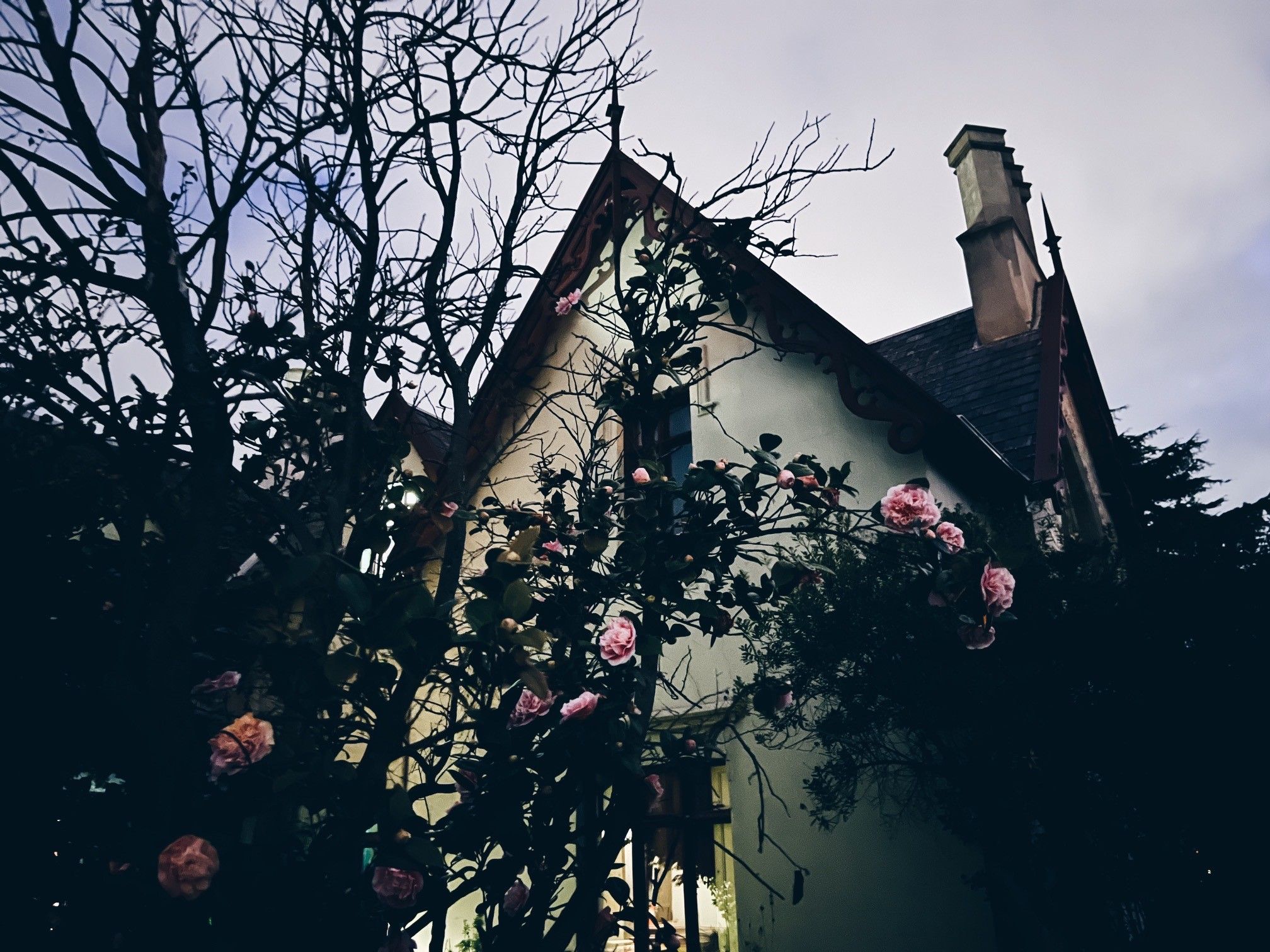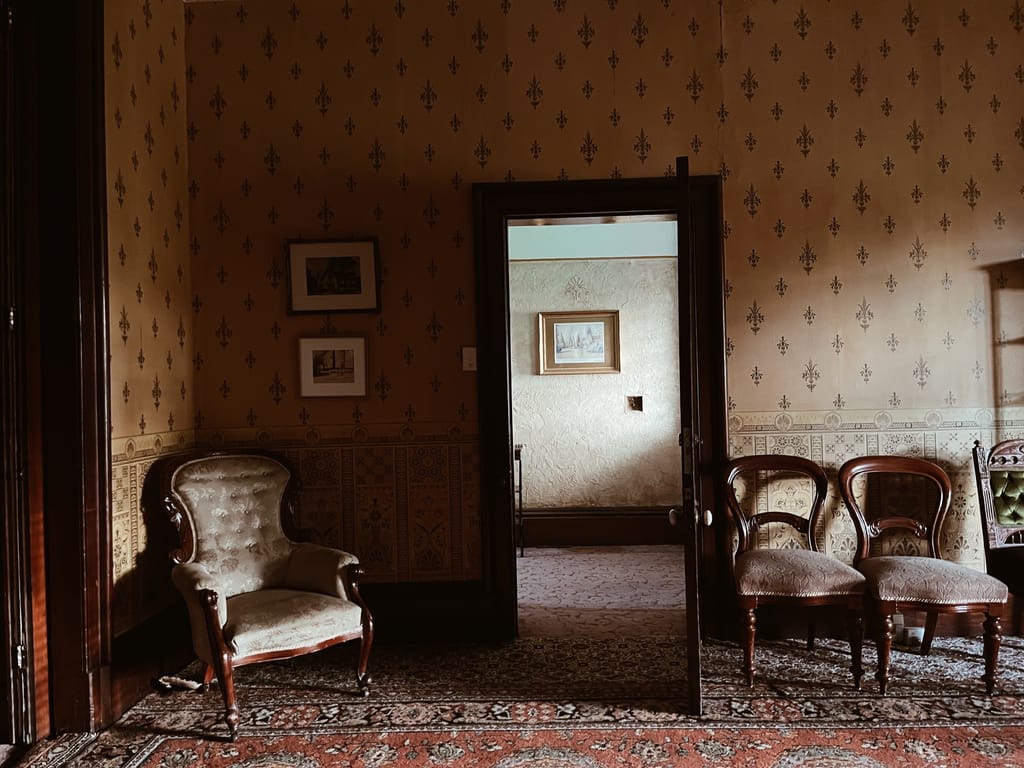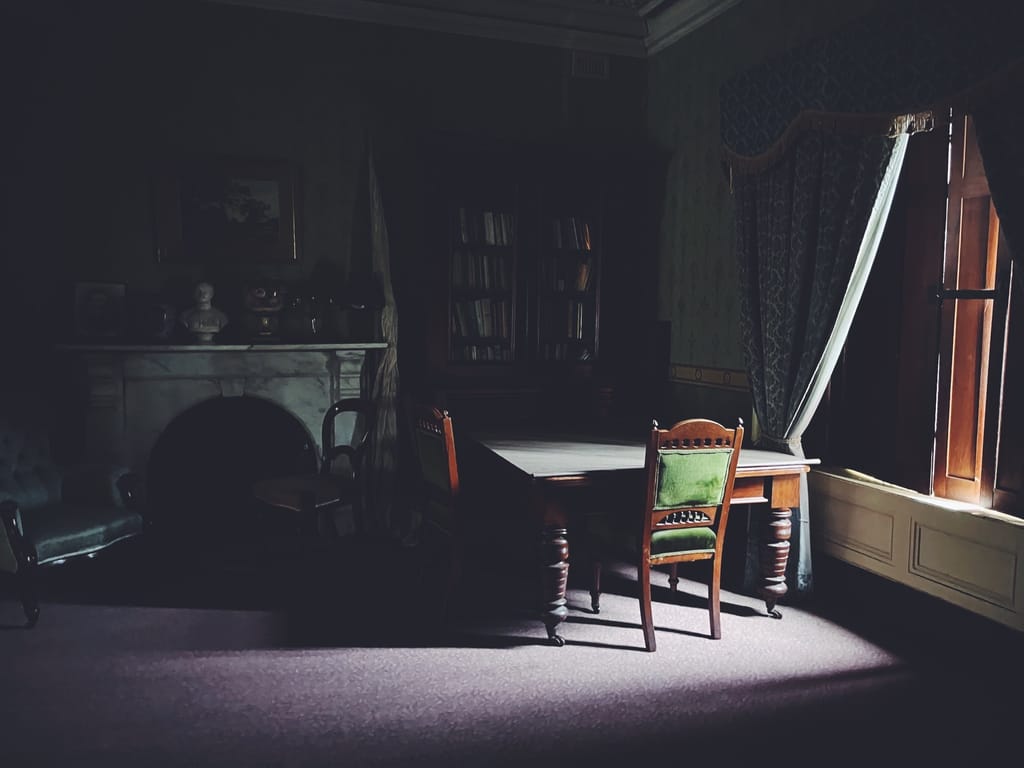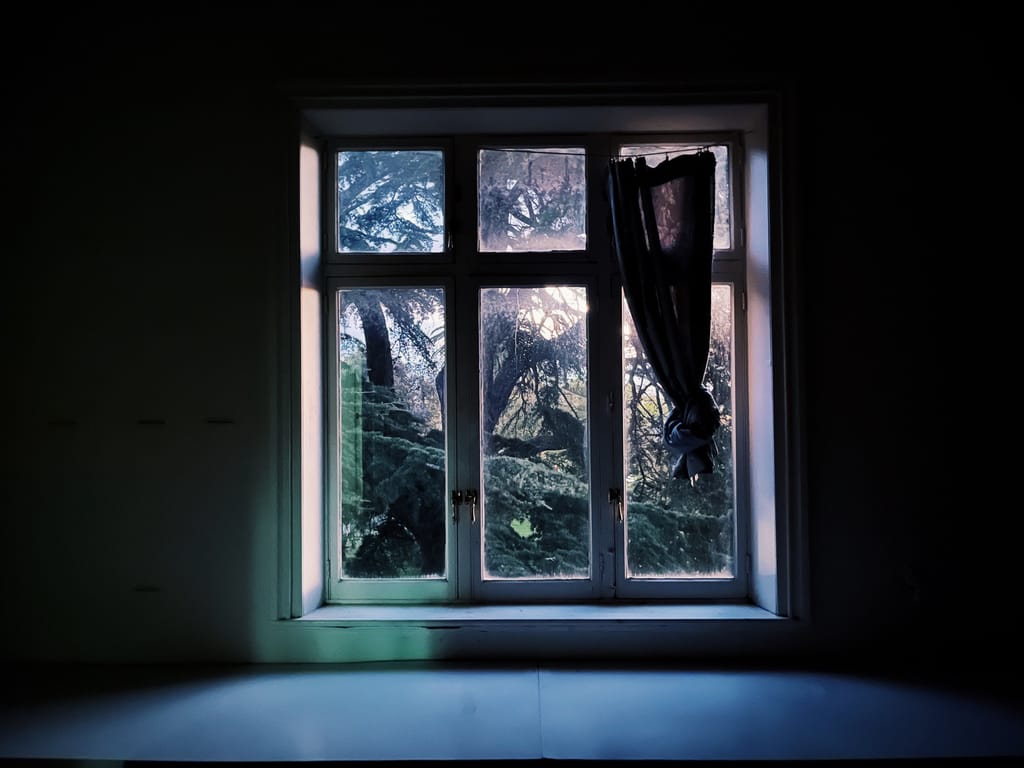
It seems there’s a rule that any house that’s old enough to be heritage listed is haunted by rumours of ghosts. I don’t like rules, but I wouldn’t break this one; I’d rather spread the rumours. Glenfern was built in 1857, a Gothic Revival mansion that tumbled through history – its structures, grounds and inhabitants changing – until it became a set of writers’ studios, owned by the National Trust and administered by Writers Victoria, in 2006. On a wall near the kitchen door, there’s a laminated newspaper article from that year, exuberant about the future of the studios. All the ghosts are friendly, I read, hovering as the kettle boils.
In 2019, I received a Grace Marion Wilson Fellowship that provided me with a studio at Glenfern. I was there for three months, but never stayed after dark. It was summer and the days were long, but I didn’t know if I believed in friendly ghosts.
~
On our first day, the three fellows were shown around Glenfern, taken into the drawing room. I’d been awarded the fellowship on the basis of a synopsis and the first 500 words of my novel; the two-sentence description on the Writers Victoria website was my first public confession that I was, in fact, writing a novel. I hadn’t slept well and was trying to be cheerful; I felt anxious and untethered, excited about the studio whilst blinking back tears over a recent breakup. After lunch, I sat on the floor of my studio, crying into the phone. On my second afternoon, I realised the walls might not be soundproof and went to cry in the garden instead. I was distracted, by the end of the month, by another crush; I told myself I was reading queer theory ‘for the novel’ when it was mostly so that I might share the reference points of the academic I was messaging on Instagram.
~
During my fellowship, I kept meaning to read the 1986 Conservation Report, a thick pile of paper with a plastic spine that sat on the bookshelf. I was attracted to Glenfern as a place, as a building with a past, as much as I was to the practical opportunities that it afforded me. I return to Glenfern, now, in 2023, to read the report and write this piece, as if testing a version of what I might have written then.

I keep thinking, as I write, that anything written about Glenfern should be choral. It seems that almost everybody who has been there feels, at least a little bit, as if Glenfern belongs to them. How to write something, in the face of these attachments, that’s neither sentimental nor straightforward elegy?
~
The images in the conservation report are photocopies of photocopies. I turn the pages, finding adults without faces, outlines of mirrors reflecting nothing, light bleaching out windows and burning holes in furnishings. I find photographs of doors, but Door No. 2 is just a black rectangle – the details, photocopied, have disappeared into darkness. I make out, in a shot of the driveway from the early 1870s, a child’s rocking horse. I wonder whose toy this was and what became of it, of them; I wonder where memories go when people vanish into time.
~
It was in 2006, officially, that writers came to Glenfern, but language operated here long before this, has carried past into present. I think of Jeannie Watson’s diary, written in 1870. Things are in a rather rum state just now, she writes, describing her fear that the family would have to leave.
~
In 1860, there were stables and a coach house, 50 head of fowls, 5 geese and a gander and a powerful grey carriage horse. In 1882, an orchard containing about 150 choice trees in full bearing.
In 1870, the cows disappeared for a week. They turned up safe and sound, though, I read, to our enchanted satisfaction.
Mrs Webster remembers cows in 1912.
~
In some ways, I’m on the same trajectory, now, as when I left Glenfern. I could describe my ‘journey’ as if there was no rupture, as if everything were smooth and linear. I was working on a novel, then; it is finished, now, and will be published in September. I was a Writers Victoria member, then; I work, now, at Writers Victoria. I suppose those months laid a foundation for the present.
~
I lose track, reading, of all the subdivisions. I knew about the flats built beside Glenfern in 1964, but not about the subdivisions prior to 1916, the streets cut into the block that was once four-acre grounds. In 1926, parties were held on tennis courts; the tennis courts have been replaced by parking spaces and the parties ended long ago.
It seems, sometimes, as if I’m reading about things that I can see. Stables and a coach house, I read, and think I’ve found familiar structures, but I read further and learn that the earlier ones were in a different location. Presumably those buildings have been demolished, I read.
There are definitely no longer any cows.
~
The history of Glenfern, I realise, is a history of loss; the shift in purpose, in inhabitants, isn’t anything new. I shouldn’t be surprised, and I’m not, really – all lives, all histories, really, are just registers of loss – and yet I’m always haunted. I wonder if all we can ever do is accept it, find the beauty in loss, imagine that the ghosts are friendly.
~
Further investigation is required, I read, again and again.
~
I let my gaze wander around the drawing room and feel transported by the wallpaper, carpet, furnishings, the nineteenth-century ambiance. Even the drawing room is a fiction, though, restored by a film crew, imagined on the basis of a painting. In a photo from 1895, it’s shown cluttered with photographs and furniture, I think – but the image, again, is barely legible.

~
I wonder, typing into a word document, if quotations themselves are like ghosts; italics, always on an angle, appear as if they might float away, have a spectral quality.
~
I never found it easy to write at Glenfern; I felt ashamed that my time there wasn’t straightforwardly productive. I never arrived as early in the morning as I hoped. I stuck postit notes and pictures on the walls, arranged books on the bookshelf, made a small floral arrangement with an empty La Croix can and a sprig of eucalyptus. I sat in the midst of all this and felt too much, cried, wrote text messages, wrote in my diary, stopped crying and fell in love, wonderous at my own happiness. I realised, at some point, that the only way to handle having feelings was to use them in writing, to travel with their current, rather than to try to push against them. It was an important lesson, I realise now.
~
I suppose that one learns, reading and writing, that history is never static, that nothing is ever entirely lost but that nothing is ever entirely found again, either. One forgets this lesson and learns it again and again. One, I write, as if I can make claims for universality, as if I can speak for anybody beyond myself.
I am a sentimental person, but I am suspicious of that. If I was the only one who romanticised Glenfern I’d remind myself that nothing lasts forever, that mourning a building is usually a means of mourning something else – but it isn’t just me, is it?
~
I am writing in a room that was once two rooms, spaces for servants. Man’s room, I read, on a plan from 1912. Dairy. The neighbouring studio is labelled as Mrs Grant’s kitchen. I see, flicking through plans and across decades, other changes: the nineteenth-century dining room became a breakfast room and then a schoolroom; the drawing room, split in two, became a bedroom and a twentieth-century dining room. Glenfern was divided into flats during the Great Depression, but this happened quickly and cheaply, so many changes were easy to reverse. Some, though, linger: there are doors that open into air; a passageway leading nowhere; the outline of a lost staircase rusted onto a wall. Site inspections were limited in the tenanted areas, I read. Two of the tenants still live upstairs.
~
There’s a part of me, still, that just wants to cry at Glenfern. It’s as luxurious to have space for strong emotions as it is to have a desk on which to write. I wonder if it’s embodied memory or if it’s a response to space and silence, to feeling outside time. Glenfern is meditative, a quiet space cleaved from the cacophony of life. I hear the distant rush of cars, the rustle of leaves in the wind. I lock eyes with a neighbour’s cat. 2023 is contained only in my phone and laptop, the shape of my body.
~
There are so many books that have been written, at least in part, at Glenfern. I can trace moments of Glenfern in my own novel, despite its New York setting – my characters, too, have a lot of feelings. Glenfern sprawls through writing, unmappable.
I suspect we become attached to places because of ways in which our lives play out against them. It’s our imaginative lives that take Glenfern as backdrop; it’s a place where ideal selves might create ideal work. Glenfern is like a doll’s house, coming alive through inventions and imitations, memories and make-believe. It seems, to me, that intimacy is made possible by spaces, literal and figurative, left imperfect and unfinished.
We share the same corridors, but it’s never possible to know what other people feel, or why they feel it; the doors of other studios are often closed.
~
I suppose, in the end, writers invent the ghosts. There are texts that are haunted by Glenfern, but words are good at haunting places, too, after all. Glenfern is an incomplete sentence, an invitation.

Anna Kate Blair is Program and Partnerships Manager at Writers Victoria. Her essays, short stories and poetry have appeared in publications including Cordite, Slow Canoe, Landfall, Antithesis, Meanjin and Litro. Her first novel, The Modern, will be published by Scribner in September 2023.
